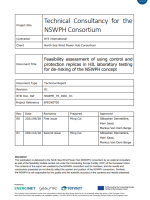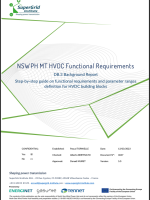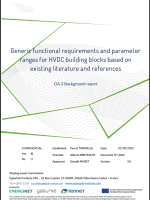Feasibility assessment of using control and protection replicas in HIL laboratory testing for de-risking the NSWPH concept
Technical Report
1 EXCUTIVE SUMMARY
This document delivers the main conclusions of the feasibility assessment of using control and protection replicas in HIL laboratory testing for de-risking the NSWPH concept. The questions and concerns raised by the NSWPH consortium have been addressed in detail, and recommendations in operating the HIL facility and rolling out a multi-vendor modularly developed HVDC-OWF project have also been provided based on the experience of RTE and RTE international. This document starts off by identifying the risks in the design and operation of an HVDCOWF project involving multi-vendor PED systems and developed over a long time-span. This is followed by an empirical de-risking methodology with focus on the recommended adequate tools, methods and models for different project development phases. Experience and internal studies conducted at RTE are shared with the NSWPH consortium in order to demonstrate the adverse impact of the identified risks and the importance of following the recommended methodology to de-risk the design and ensure stable system operation.
It then embarks on the discussion of the approach of using the HIL setup with real-time simulation and C&P replicas, highlighting particular considerations that should be taken into account with respect to the application (i.e., HVDC, OWF) and purpose (i.e., study, maintenance). The advantages and limitations of such an approach to de-risking the design and operation of the NSWPH project are supported, once again, using practical experience and knowledge base of RTE and RTE international.
Moreover, the financial, infrastructural, and human resource aspects of operating HIL laboratory facilities have been addressed, offering further insight into the project roll-out in terms of resource preparation and management. Finally, the questions and comments received from the NSWPH consortium upon their review of revision R0 have been responded to and provided in Section Q&A. It should be noted that the solutions, propositions, recommendations, and advice are presented strictly based on our experience and the technological status quo that is relevant solely to the currently available technical development and solutions. It is possible that certain implementation constraints will be relaxed, and enhanced solutions will become available with future technical advancement, which would entail further studies thus is out of the scope of this document.
It is believed that this report of feasibility assessment can help the NSWPH consortium with their decisions on whether or not to use the HIL setup with C&P replicas in interoperability studies and how to efficiently and effectively carry out all necessary testing and study activities using the HIL lab facilities with proper resources.





